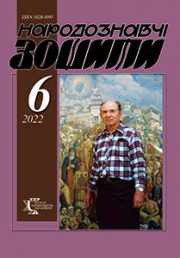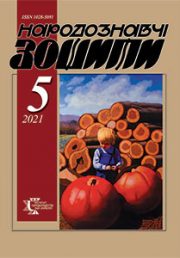The Ethnology Notebooks. 2020. № 5 (155), 1037—1050
UDK 638. 14 : 39] (477. 83 + 477. 86 /. 87)
DOI https://doi.org/10.15407/nz2020.05.1037
ТRADITIONAL BEEKEEPING OF UKRAINIANS OF HUTSUL REGION: THE SPECIFICS OF PRODUCTION CULTURE
MOVNA Ulyana
- Doctor of Historical Sciences, Senior Researcher
- the Institute of Ethnology of the National Academy
- of Sciences of Ukraine,
- the Department of Historical Ethnology,
- Svobody Avenue 15, 79000, Lviv, Ukraine
- Contacts: e-mail: movlana@ukr.net
Abstract. The article is the first attempt to outline the main features of the economic and production complex of traditional Hutsul beekeeping as a significant segment of Ukrainian ethnic culture on the basis of materials of own field searches and literature and museum sources, which determines its relevance. The object of our research is traditional beekeeping of Hutsuls, and the subjects are processes, which creates technology culture of apiculture of Ukrainians in Hutsul region and artifacts as the result of them (apiary arrangement, bee keeping, reseiving of honey and their application, types of beehives and features of their design, types of beekeeper equipment). The study used comparative, typological, structural-functional methods and method of field researchers.
The important role of types and designs of traditional frame hives (logs, hollows, straw baskets) and modified rational dwellings for bees (Slavs, Ukrainian beds, Dadans) is emphasized. The focus is on the folk experience of insect breeding — traditional knowledge of the apiary, the annual production beekeeping calendar (swarming, wintering outdoors and indoors, methods of prevention and treatment of diseases). The significant value in the process of optimization of care of bees is played by apiary accessories — protective face nets, chimneys, pumps, robes, honeycombs. The process of obtaining bee products is considered, in particular technological methods of honey harvesting, depending on the type of beehives, and methods of production operations waxing. Obtaining honey and the feasibility of its economic use was dictated by the appropriate technological methods of honey collection in collapsible and non-collapsible hives, time and conditions of storage of sweet product.
Since there have been no research works conducted on that subject, the article is based on the field materials gathered by the author. After analyze the significant number of ethnographical field and sporadic bibliographical sources the historical roots and prevalence are proved and the regional specifics of beekeeping as a traditional economic occupation of Hutsuls are clarified.
Keywords: beekeeping, industrial culture, beehive, traditional, Hutsul.
Received 31.07.2020
REFERENCES
- Movna, U. (2000). From the history of beekeeping in the Carpathians and Prykarpattia orms of beekeeping from ancient times to the XVII—XVIII centuries). The Ethnology Notebooks, 5, 851—859 [in Ukrainian].
- Rozov, V. (1928). Ukrainian diplomas (Vol. 1). Kyiv [in Ukrainian].
- (1895). Sources for the history of Ukraine-Rus’ (Vol. 1). Lviv [in Ukrainian].
- Mandybura, M. (1978). Polonyn economy of the Hutsul region in the second half of XIX
- 30’s of the XX centuries. Kyiv: Naukova dumka [in Ukrainian].
- Falkowsky, J. (1937). The western border of the Hutsul region. Lviv [in Polish].
- Archive of the Institute of Ethnology of the National Academy of Sciences of Ukraine (Archive of the IN NANU). F. 1. Op. 2. Act. 413. (Movna U. Traditional beekeeping. Field materials from the Hutsul region, 1995) [in Ukrainian].
- Archive of the Institute of Ethnology of the National Academy of Sciences of Ukraine (Archive of the IN NANU). F. 1. Op. 2. Act. 435. (Movna U. Field materials on traditional beekeeping of Hutsul region. Kosiv, Nadvirna districts. 1997) [in Ukrainian].
- Zakrevska, J. (Ed.). (1991). Hutsul region: linguistic studies. Kyiv: Naukova dumka [in Ukrainian].
- Shukhevich, V. (1908). Hutsul region. Materials on Ukrainian ethnology (Part 5, vol. 7). Lviv [in Ukrainian].
- Falkowsky, J. (1938). The north-eastern border of the Hutsul region. Lviv [in Polish].
- Leonovich, S. (1932). The village of Chornoholova is under economic and social review. Subcarpathian Rus’, 4—5, 32—35 [in Ukrainian].
- (1991). Beekeeping. Small encyclopedia. Moscow: Soviet encyclopedia [in Russian].
- Witwicky, S. (1863). Historical outline about Hutsuls. Lviv [in Ukrainian].
- Shukhevich, V. (1899). Hutsul region. Materials on Ukrainian ethnology (Part 1, vol. 2). Lviv [in Ukrainian].
- Schnaider, J. (1906). Pechenian people. Ethnographic sketch. People, 12, 277—308 [in Polish].
- Ciesielsky, T. (1901). Beekeehing (Vol. 2) [in Polish].
- Starchuk, I. (1932). Apiary in the village of Babyn (Kosiv region). Life and Knowledge, 7, 197—198 [in Ukrainian].
- Dragan, M. (1937). Ukrainian wooden churches. Genesis and development of forms (Vol. 1). Lviv [in Ukrainian].
- Archypenko, J. (1927). On the question of a uniform framework for the Slavonic peoples. Ukrainian beekeeping, 7, 80—81 [in Ukrainian].
- Danyliuk, A. (1980). Museum of folk architecture and life in Lviv: a guide. Lviv: Kamenyar [in Ukrainian].
- Skurativsky, V. (1980). Traditional forms of beekeeping buildings and complexes in Ukraine. Folk art and ethnography, 6, 42—50 [in Ukrainian].
- Movna, U. (2006). Customs and rites of Ukrainian beekeepers of the Carpathians and Prykarpattia of the XIX — beginning of the XX century. Lviv [in Ukrainian].
- Myloradovych, V. (1991). The life of a Lubny peasant. Ukrainians: folk beliefs, superstition, demonology (Pp. 170—341).Kyiv: Lybid [in Ukrainian].
- Wolsky, K. (1960). From research on ancient beekeeping techniques in the San basin. Przemysl [in Polish].
- Movna, U. (2007). Honey in the Carpathians and Prykarpattia: a retrospective view. Boykivshchyna (Vol. 3, pp. 324—329) [in Ukrainian].






